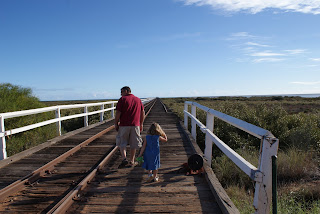Canarvon
In the 1880's when Canarvon was first established the main street was built for camel trains to turn around in- it was a massive 40 metres wide! Nowadays camels trains have been replaced and the town is a centre for sheep and cattle grazing. Water from the Gascoyne River has now enabled the area to become famous for it's delicious tropical fruit and vegetables.
Mile Long Pier
In 1897 a mile long timber jetty was built to service the live sheep and cattle export trade. The last vessel to berth here was in the early 1980's and since then the pier has been restored for recreation and tourist use. A visitor centre is currently being constructed. It was a long walk for little legs over a rickety bridge, mangroves and salty water, but so much fun, especially when we caught the "Coffee Pot" train back to shore. We didn't hang around town long enough to go fishing- but we chatted to some keen fishermen who had caught plenty of small flathead at the end of the pier. (I'm figuring from the amount of fishing gear they had with them they'd caught the train both ways)
Heading from Canarvon to Exmouth we encountered many termite mounds- commonly called anthills. They are pretty impressive structures, serving as accomodation, food storage and temperature regulating structures. The mound is built above the subterranean nest and is a complex system of ventilation shafts and tunnels. They come in a variety of colours depending where they are located given that they are created from the soil nearby. They are also found in different shapes, tall, thin, wide, sometimes smooth, or rough in surface texture. They are solid to touch and not easily destroyed, although when they are compromised the termites work quickly on repairs. I'm certain there will be more of these to be seen during our adventures.
















No comments:
Post a Comment